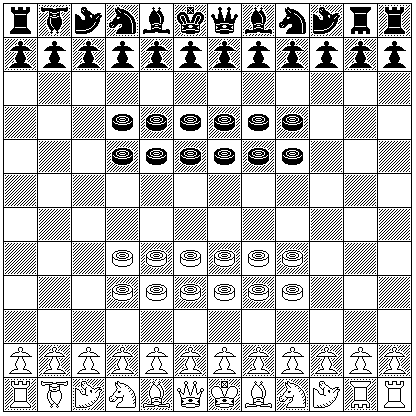
Here is a variant for the 12 by 12 board:

The main layout, which resembles that for Carerra's 1617 invention that anticipated Capablanca's Chess, has the following sequence of pieces on the back row:
Rook Princess Camel Knight Bishop Queen King Bishop Knight Camel Empress Rook
The Princess moves either as a Bishop or a Knight, and the Empress moves as a Rook or a Knight, and the Camel has a move similar to that of the Knight, but elongated, so that each move shifts it one space in one orthogonal direction and three spaces in a perpendicular direction.
So far, that may not seem all that exciting. But since the board is 12 by 12, instead of 12 by 8, another 24 pieces have been added so that, as in regular Chess, half the squares have pieces on them.
And what do all those checkers in the middle of the board do?
Well, their move is a little like that of a piece in the game of Checkers, but not that much; the move they have been given is quite different, drawing inspiration from Ludus Latrunculorum as well as Checkers.
For the moment, at least, I will still refer to these pieces as Checkers, despite the differences in the nature of their move. The Checker in this game moves as follows:
It moves, but does not capture, one square orthogonally, forwards, backwards, or sideways.
As well, it can jump allied pieces to move, but not capture, in an orthogonal direction, with repeated jumps as in Checkers.
On the other hand, it can jump enemy pieces to capture them, diagonally only, again with repeated jumps as in Checkers. As in Chess, captures are completely optional. Note that a series of jumps may only consist either entirely of orthogonal movement jumps or diagonal capturing jumps, and never a mixture of the two.
In addition, it is capable of custodian capture: if it moves so that an enemy piece is between itself and another allied piece, that enemy piece is captured. Custodian capture may take place along either orthogonal or diagonal lines.

Also, the fact that captures are completely optional applies to captures within the same series of jumps as well. Thus, in the diagram shown at right, the Checker may jump over the Knight to capture it without also having to continue the series of jumps to capture the Pawn. Instead, it can end its move after capturing the Knight, and, as a result of arriving on the square beyond the Knight at the end of its move, it will then on the same move capture the Bishop by custodian capture.
Note, therefore, that custodian capture does not take place on intermediate squares at which a piece may pause during a series of jumps that continues from those squares.
Finally, it does not give check through threatening to jump over the enemy King or through the threat of custodian capture of the enemy King. Instead, check is the threat of capture by replacement, as carried out by a normal Chess piece, in the case of the King. This replacement move can be any otherwise legal move for the piece; thus, while a King is not in check when diagonally adjacent to an enemy Checker, since jumping is not a valid threat, it not only is in check when orthogonally adjacent, it is in check when it is on the square diagonally beyond a piece over which the Checker could jump to capture that piece had the square the King was on been empty, and similarly it is also in check when it is on the square orthogonally beyond an enemy piece over which the Checker could have jumped for movement had the square the King was on been empty.

The image at left shows some of the implications of these rules.
In diagram 1, the Black King is not in check, because capture by jumping is not a means of giving check.
In diagram 2, the Black King is in check, because the normal move of a Checker is one space orthogonally, and the Checker gives check through the threat of capture by replacement.
In diagram 3, the Black King is also in check, since jumping over the Black Knight would move it to the square on which the King is located. Since the King is subject to check through the threat of capture by replacement, its square is equivalent to an empty square for determining if jumping is permissible.
In diagram 4, the Black King is again in check, as this applies to orthogonal jumping over an allied piece to move as well as diagonal jumping over an enemy piece for capture.
Because custodian capture requires an allied piece behind the enemy piece, and jumping requires a vacant space behind the enemy piece, were it not for the modified rule regarding checks, an onslaught of Checkers could be completely ignored by the initial array of Chessmen, as it consists of two rows of pieces of the same color.
Essentially, the idea is that:
The positioning of the two arrays of Checkers makes it seem likely that they will battle it out before the other Chessmen fully enter the fray, hence the name of the variant, Prequel Chess, but likely they too will be brought into the game to influence that contest.